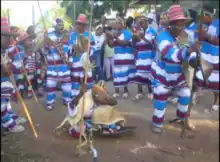Kambaata people
Kambaata people also spelt as Kambata or Kembata (Amharic: ከምባታ) are a Cushitic ethnic group that inhabit the Southern Nations, Nationalities, and Peoples' Region of Ethiopia. They speak the Kambaata language, It was a province of Ethiopia beginning in the early 15th century through to the mid-17th century; Ethiopian rule was once again established in the late 19th century under Emperor Menelik II. During this first period, Kambaata province was largely Christianized.[1] The former province is contained within the contemporary Kembata Tembaro Zone of SNNPR.

People
The Kambata tribe is one of the indigenous tribes in Ethiopia. Scientists categorize the Kambata as a highland east Cushitic tribe. In a broader sense, the term Kambata people, is used to describe the various clans and groups of Kambata [Kambata, Alaba, Tambaro]. In a narrow sense, it refers to inhabitants around the heartland of mbaricho massif. These three autonomous groups speaking dialects of the sameA language are collectively referred to as the Kambata people. The differences between the various groups of Kambata are not very strict. People are astonishingly mingled, intermarried and spoke one another’s languages. It is, herefore, difficult to specify clear boundaries of these groups
Demographics

According to Ethiopian statistics, the population of the Kambaata people was 5, 627,565,[2] of which 90.89% live in the Southern Nations, Nationalities, and People's Region. Almost one in five – 18.5% – live in urban areas.[3]
The Kambaata people speak the Kambaata language, a Cushitic language.
History
The Kingdom of Kembata was ruled by long line of its own kings known as down. King Dagoye, from the Oyeta clan, was one of the famous kings known for expanding Kambata territories. The last independent king of Kambaata was king (Woma) Delbato Degoye.
An important landmark for the Kambaata people is Mount Hambaricho, where their king, Woma, used to live and the people used to celebrate annual festivities in the past. The king and the god of Kambaata lived there.
Language
Kambata language [self‐name Kambatissa], [also Kambatigna in Amharic] is one of the official languages of Ethiopia. It is a little known language, spoken by less than 1milion speakers. It includes a number of dialects, such as Alaba, Tambaro and ebena. It is closely related to the Sidama and Hadiya languages spoken in the neighboring regions. According to linguists, Kambata is classified as a Cushitic language, named after the biblical character Cush. Cushitic languages are part of the larger Afro‐asiatic language family spoken in Horn of Africa. Both the Latin script and Ge'ez script is used for writing. For example, the Bible [full New Testament and part of the Old Testament] is written in Ge’ez script. However, according to researchers, the official established spelling usage [orthography] taught currently in primary schools in the region, deviates from the International Phonetic alphabet convention. For example, the word Kambata is written as Kambaata where double letters “aa” indicate the length. The language of inter‐ethnic communication is Amharic, the national language of Ethiopia. Kambatas have Amharic names, and some even speak Amharic as their first language. These days, traditional Kambata names are hardly given to children. English is the only spoken foreign language, and is the language in which secondary school are taught.
Subsistence
They have various indigenous traditional cuisines, the most important of which is kocho, which is made from ensete. They also cultivate a variety of tubers, spices, coffee, crops, and vegetables.
Other clans in Kembata province, such as Tembaro, Alaba, and others, live together and form the Kambaata. Tanners Shekla Seriwoch is the most secluded clan in Kembata province; this clan is unable to participate in any socioeconomic activity with Kambaata. Tanners clan and Kambaata people could never marry.
Kambaata is one of the most densely populated regions in Ethiopia. Due to overpopulation and lack of economic opportunities in their region, they migrate to large cities, industrial areas, and large plantation farms. In recent years they experienced a large influx of migration to South Africa and Middle Eastern countries.
Notable Kambata
- Biruk Lambiso – is a professor at Addis Ababa University
- Aklilu Tizaz – is a professor at Addis Ababa University
- Adane Girma – Ethiopian National Team Football Player
- Shimelis Bekele – Ethiopian National Team Football Player
- Loza Abera – Ethiopian National Team Football Player
- Belachew Girma – A laughter king (Ethiopian Celebrity)
- ...
References
- Ulrich Braukämper, "Aspects of Religious Syncretism in Southern Ethiopia", in Journal of Religion in Africa, 1992, p.197.
- Summary and Statistical Report of the 2007 Population and Housing Census
- 2007 Ethiopian census, first draft Archived 14 February 2012 at the Wayback Machine, Ethiopian Central Statistics Agency (accessed 6 May 2009)
Further reading
- Arsano, Yacob, "A traditional Institution of Kambata" (2002). In: Bahru Zewde and Siegfried Pausewang(eds.), Ethiopia. The Challenge of Democracy from below. Uppsala
- Braukämper, Ulrich. 1983. Die Kambata: Geschichte und Gesellschaft eines süd-äthiopischen Bauernvolkes. Wiesbaden: Franz Steiner.
- Gebrewold-Tochalo, Belachew (2002), The Impact of the Socio-Cultural Structures of the Kambata/Ethiopia on their Economic Development. Vienna.
- Gebrewold, Belachew, "An introduction to the political and social philosophy of the Kambata" (Kambata Development Network website)
- Daniel Yoseph Baiso, Occupational Minorities in Kambata Ethnic Group, Nairobi, 2007
- Ashenafi Yonas Abebe, "Resignificacion de algunos valores culturales del pueblo Kambata-Etiope esde el mensaje evangélico", Bogota, 2008.